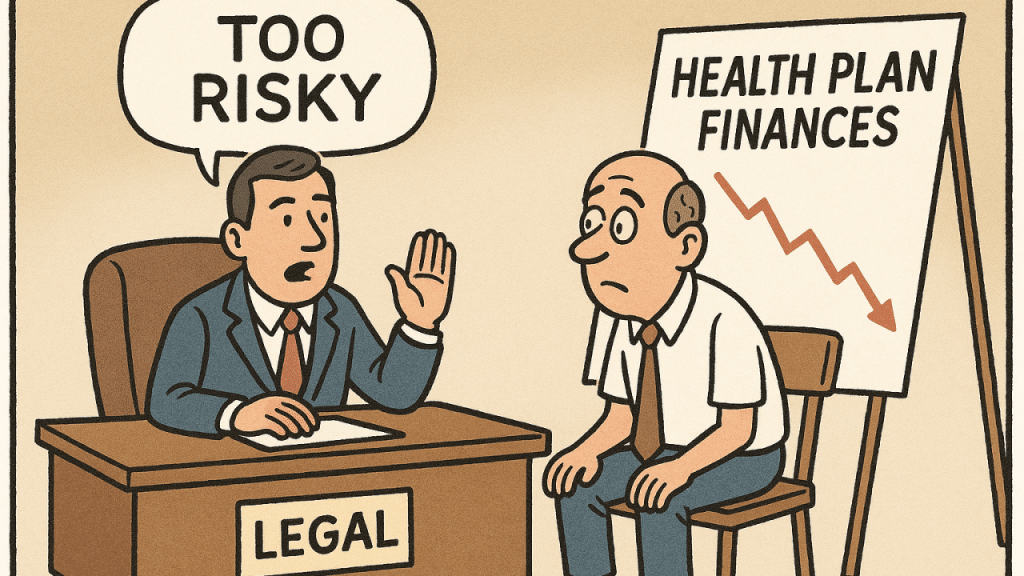
(I’m not a lawyer — but I read books, so it pretty much makes me an expert in today’s standards.)
The healthcare industry is full of brilliant intentions that never see daylight.
Every conference stage, every strategy deck, every fireside chat you’ll hear the same hopeful lines:
“We want to improve outcomes.”
“We’re focused on prevention.”
“We’re reimagining care delivery.”
Then the idea hits Legal, and the air leaves the room.
The lawyers aren’t villains. Their job is survival, to protect the organization from lawsuits, compliance risk, and the kind of headline that gets boards sweating. Their north star is avoid harm.
The problem is that over time, that mindset morphed into avoid movement at all costs.
Healthcare has perfected the art of playing defense.
But here’s the uncomfortable truth: risk aversion has become the biggest risk factor in the industry.
The Consequences of Playing It Too Safe
By saying “no” to the possibility of something going wrong, we’ve created a system where everything is going wrong slowly, expensively, and predictably.
𝗙𝗶𝗻𝗮𝗻𝗰𝗶𝗮𝗹𝗹𝘆: Margin erosion has become structural. Most health plans operate in negative or near-zero operating margins. The “safe” route, status-quo, doing more of the same is publicly bankrupting the system.
𝗖𝗹𝗶𝗻𝗶𝗰𝗮𝗹𝗹𝘆: We spend trillions managing disease reactively instead of pennies preventing it proactively. Our outcomes are declining, not because of lack of intelligence, but because of lack of permission.
𝗛𝘂𝗺𝗮𝗻𝗹𝘆: Clinicians are leaving. Members are disengaged. Trust is evaporating. And everyone in the system feels trapped by the same invisible wall: liability fear 𝘥𝘪𝘴𝘨𝘶𝘪𝘴𝘦𝘥 as leadership.
𝗪𝗵𝗮𝘁 𝗕𝗮𝗹𝗮𝗻𝗰𝗲 𝗥𝗲𝗮𝗹𝗹𝘆 𝗟𝗼𝗼𝗸𝘀 𝗟𝗶𝗸𝗲
Finding balance isn’t about silencing Legal or overruling Risk. It’s about redefining what “risk” even means.
Design Risk Don’t Just Avoid It.
Create controlled innovation zones. The same way CMS uses pilot waivers and demonstration models, health systems can sandbox ideas under structured compliance. “Legal-safe” doesn’t mean “creatively dead.”
Quantify the Risk of Inaction.
Every legal team understands exposure. So what is the exposure of doing nothing. Lost margin. Avoidable readmissions. Preventable maternal deaths. When inaction becomes a measurable liability, “no” loses its moral high ground.
Shift from Gatekeeping to Co-Creation.
The old model: “Innovation builds, Legal reviews.”
The new model: “Innovation and Legal design together.”
Compliance can be built in, not bolted on.
Anchor Boldness to Precedent.
CMS, OCR, and FDA all offer guidance that innovation leaders can use as cover. The magic phrase for Legal: “We’re not first we’re following federal precedent.”
The Truth …
Healthcare isn’t too regulated to innovate. It’s too scared to.
The system talks endlessly about risk, but refuses to admit that inaction is now the riskiest strategy in the room.
We can’t regulate our way to transformation. We can only design our way through it by reframing risk as something to manage intelligently, not something to flee from reflexively.
Because when your finances are deteriorating, your outcomes are embarrassing, and your workforce is exhausted, doing nothing isn’t safe.
It’s negligent.
(Again, not legal advice. Just book advice.)

MyRoad.io provides Targeted, Relevant, and Timely Data. Schedule a consultation to integrate into your sales funnel.

